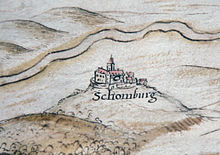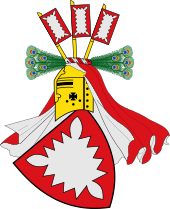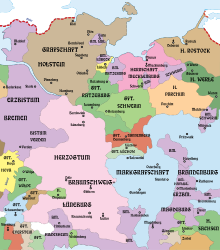Schaumburg County
|
Territory in the Holy Roman Empire |
|
|---|---|
| Schaumburg County | |
| coat of arms | |

|
|
| map | |

|
|
| Map of the two successor territories of the Principality of Schaumburg-Lippe and the County of Schaumburg from 1866
|
|
| Form of rule | county |
| Ruler / government | Count |
| Today's region / s |
DE-NI
|
| Reichskreis | Lower Rhine-Westphalian |
| Capitals / residences | Bückeburg and Stadthagen |
| Dynasties | Counts of Schauenburg and Holstein , Holstein-Schauenburg |
| Language / n |
German
|
| Incorporated into | 1640 Division into Grafschaft Schaumburg-Lippe and Grafschaft Schaumburg in personal union Landgraviate Hessen-Kassel
|
The county of Schaumburg was a territory in the Holy Roman Empire of the German Nation . The county existed until 1640, when it was divided between the Landgraves of Hessen-Kassel and the Counts of Lippe after the death of the last Count of Schauenburg and Holstein .
history
The county is named after the Schaumburg castle ( called Schauenburg from 1106 to approx. 1485 , only afterwards corrupted to Schaumburg, it is now in the urban area of Rinteln ), after which a noble family named itself since the beginning of the 12th century from 1110 to 1460 was enfeoffed at the same time with Holstein and Stormarn . The Schaumburg coat of arms, the so-called Nesselblatt (actually a coat of arms with a decorative border), can still be found today in the Schleswig-Holstein state coat of arms, as well as in the coats of arms of the cities of Kiel , Neustadt in Holstein , Preetz and Plön , those of the Counts of Schauenburg and Holstein (also called Schauenburg ) were founded.
In 1110, Duke Lothar von Supplinburg appointed his liege, Adolf I , Lord of the Schauenburg, to succeed Gottfried von Hamburg , who had died fighting the Slavs, as Count of Holstein. Adolf I and his successors fought against the Slavs and colonized and proselytized mainly in East Holstein . Adolf III. received areas around the ancestral castle from Heinrich the Lion in gratitude for his support. In 1261 the sons of Adolf IV divided the rule among each other and formed several lineages , which further fanned out in further divisions of the inheritance. The reign over the ancestral rulership was connected with the Holstein-Pinneberg line (also called Holstein-Schauenburg ) since 1290 . In 1295 the rule of Schauenburg was raised to a county. After the other lines became extinct, the powerful Rendsburg line took over their territory, so it ruled all of Holstein up to the Pinneberger district and was temporarily enfeoffed with the Duchy of Schleswig . In 1459, with Adolf VIII, the Schauenburg rule in Holstein ended. The Pinneberger line could not enforce their claims on the county of Holstein and the duchy of Schleswig.
| Holstein | |||||||||||||||||||||||||||||||
|
Holstein-Kiel (1261-1390) |
Holstein-Itzehoe (1261-1290) |
||||||||||||||||||||||||||||||
|
Holstein-Segeberg (1273–1308) |
|||||||||||||||||||||||||||||||
|
Holstein-Plön (1290-1390) |
Holstein-Rendsburg (1290-1459) |
Holstein-Pinneberg (1290-1640) |
|||||||||||||||||||||||||||||
|
Duchy of Holstein (from 1474) |
|||||||||||||||||||||||||||||||
|
County of Rantzau (1650–1726) |
|||||||||||||||||||||||||||||||
|
|
|
|---|---|
| The county of Schauenburg (light blue area in the red circle) around 1250 |
South of the Elbe, the town of Stadthagen and Rinteln were founded by the Counts of Schauenburg . They were also in the Deister wealthy -Vorland and in the 13th century Gografen the district Wennigsen why them the Bailiwick of Wennigsen monastery was assumed. The count family donated property to the monastery. The County of Sternberg has belonged to the Schauenburg estate since 1377 . In 1402/05 it was pledged to the noble gentlemen at Lippe.
Count Johann IV. Von Schauenburg and Holstein-Pinneberg received the rule of Gemen through his marriage to Cordula von Gehmen in 1476 . Their son Jobst I left Gemen to his second youngest son Jobst II , while his older brother Otto IV ruled over the town of Schauenburg and Holstein-Pinneberg. As promised in the marriage contract with his second wife, Elisabeth Ursula von Braunschweig-Lüneburg , Otto introduced the Reformation in the county of Schaumburg on May 5, 1559 . He had waited until his brothers Adolf , Archbishop of Cologne from 1547 to 1556, and Anton , Archbishop of Cologne from 1557 to 1558, had died, since they were both staunch opponents of the Reformation.
The county flourished under Otto's son Ernst . The residence was moved to Bückeburg . In 1619 the county was elevated to a principality. Since Ernst had no children, the last two Graf Schaumburg counts, Jobst Hermann and Otto V , came from the Gemener branch. With Otto's death, the family died out in 1640.
The county of Schaumburg has belonged to the Lower Rhine-Westphalian Empire since 1500 .
division
In 1640 the Grafschaft Schaumburg was divided between the House of Braunschweig-Lüneburg , the Landgraves of Hessen-Kassel and the Counts of Lippe .
Grafschaft Schaumburg in the Landgraviate of Hessen-Kassel

The Hessian part was called Grafschaft Schaumburg in personal union with the Landgraviate of Hessen-Kassel . Hessen-Kassel set up a central administration for this area with the government of Rinteln. These included the following offices:
- City of Rinteln
- City of Obernkirchen and the Bailiwick of Hattendorf consisting of the villages Altenhagen , Antendorf , Becke , Bernsen , Borstel , Cathrinhagen , Escher , Hattendorf , Klein Holtensen , Kreyenhagen , Langenfeld , Liekwegen , Poggenhagen , Pohle (proportionally; the rest to the Office Rodenberg), Raden , Rannenberg , Rehren , Rolfshagen , Röhrkasten , Schernbeck , Schoholtensen , Westerwald , Wiersen and the farms Bodenengern, Kattenbruch, Nienfeld, Oelbergen , Südhagen and Wormsthal
- City of Oldendorf and the Vogtei Fischbeck consisting of the villages Barksen , Bensen , Fischbeck , Haddessen , Höfingen , Krückeberg , Pötzen , Weibeck , Wickbolsen and Zersen
- City of Rodenberg and Amt Rodenberg consisting of the villages Algesdorf , Apelern , Beckedorf , Groß Hegesdorf , Groß Nenndorf , Grove , Haste , Heidbrinck , Helsinghausen , Hohnhorst , Horsten , Iddensermohr , Klein-Hegesdorf , Klein-Nenndorf , Kreuzriehe , Lyhren , Math , Mühlenstraße , Niengraben , Nordbruch , Ohndorf , Ottensen , Pohle (proportionately, the rest to the Vogtei Hattendorf), Rehren , Rehrewiese , Reinsdorf , Reinsen , Reinebold , Riehe , Riepen , Rodenbergerthor , Schöttlingen , Soldorf and Waltringhausen
- City of Sachsenhagen and Amt Sachsenhagen (most recently part of the Amt Rodenberg) consisting of the villages of Auhagen , Düdinghausen and Kuhle
-
Amt Schaumburg Schloss Schaumburg , the Weser Vogtei, the Vogtei Exten and the Möllenbeck Monastery Court
- Weser Vogtei includes the villages of Ahe , Deckbergen , Engern , Großenwieden , Kleinenwieden , Kohlenstädt , Ostendorf , Rohden , Rosenthal , Segelhorst , Todenmann , Welsede and Westendorf
- Vogtei Exten includes the villages of Exten , Friedrichshöhe , Friedrichswald , Hohenrode , Krankenhagen , Sarbsa , Strücken , Uchtdorf , Volksen , Wennenkamp and Weseberg
- Möllenbeck Monastery Court included Möllenbeck and Hessendorf
In 1821 in the Electorate of Hesse , the separation of the jurisdiction of the administration implemented. The county of Schaumburg was formed as a district in the province of Niederhessen for administrative matters. In 1866 this part, like the entire Electorate of Hesse, was annexed by Prussia and incorporated into the new Prussian province of Hesse-Nassau , where from 1904 it was run as the County of Grafschaft Schaumburg (seat in Rinteln ). After an administrative reform within Prussia, the district was assigned to the province of Hanover in 1932 . After the Second World War , the district came under British occupation and in 1946 became part of the state of Lower Saxony .
Schaumburg-Lippe county
The Lippe part was continued under the name Grafschaft Schaumburg-Lippe as an independent county and rose to the principality of Schaumburg-Lippe in 1807 by Napoleon's grace after Count Georg Wilhelm joined the Rhine Confederation in 1807 . In 1815 the principality joined the German Confederation and after 1871 became a member state of the German Empire . Prince Adolf zu Schaumburg-Lippe renounced the throne on November 15, 1918.
After the First World War , Schaumburg-Lippe became a free state within the Weimar Republic . In 1946 this went up in Lower Saxony . Administratively, the state of Schaumburg-Lippe consisted of the two districts of Stadthagen and Bückeburg , which were combined to form the district of Schaumburg-Lippe (seat in Stadthagen ) in 1948 . By merging the largest part of the Schaumburg-Lippe district (excluding the "Seeprovinz" around the Steinhuder Meer) with the largest part of the Grafschaft Schaumburg district (excluding Hessisch Oldendorf), today's district of Schaumburg was created .
literature
- Stefan Brüdermann (ed.): Schaumburg in the Middle Ages, (Schaumburger Studies 70) Bielefeld 2014.
- Helge bei der Wieden: Schaumburg Genealogy: Family Tables of the Counts of Holstein and Schaumburg - also Dukes of Schleswig - up to their extinction in 1640 ; with 6 Stammtaf, Melle 1999 (Schaumburger studies 14).
- Höing, Hubert (ed.): The Schaumburg area: for the historical justification of a regional identity, Melle 1998 (Schaumburger Studies 57).
- Gudrun Husmeier: Historical place directory for Schaumburg (= Schaumburger studies. Vol. 68 = publications of the historical commission for Lower Saxony and Bremen. Vol. 239). Publishing house for regional history, Bielefeld 2008, ISBN 978-3-89534-688-0 .
- Walter Maack : The history of the county of Schaumburg. A representation of their story. 3rd, expanded edition. Bösendahl, Rinteln 1986, ISBN 3-87085-106-6 .
- Schaumburg Landscape: Schaumburger Land. A little knowledge of the country. 3rd edition, Bückeburg 2013.
- Günther Schmidt: The old county of Schaumburg: Foundation of the historical geography of the state of Schaumburg-Lippe and the county of Rinteln, Göttingen 1920.
Web links
Individual evidence
- ↑ 750 years of Wennigsen 1200–1950. Published by the preparatory committee for the 750th anniversary of the community of Wennigsen, Wennigsen (printed by Buchdruckwerkstätten Hannover) 1950, pp. 8–9.
- ↑ Werner Führer: Schaumburg-Lippe . In: Theologische Realenzyklopädie (TRE), Vol. 30, pp. 80–83, here p. 80.
- ↑ Werner Führer: Schaumburg-Lippe . In: TRE, Vol. 30, pp. 80-83, here pp. 80-81.
- ^ Kur-Hessischer Staats- und Adress-Kalender: 1818, S. 216 ff. Digitalisat .
- ↑ Accession agreement regarding the accession of your nobles, Princes Paul Alexander Leopold II of Lippe-Detmold and Georg Wilhelm von Schaumburg-Lippe to the Rhine Confederation. from April 18, 1807 (on: documentarchiv.de )



